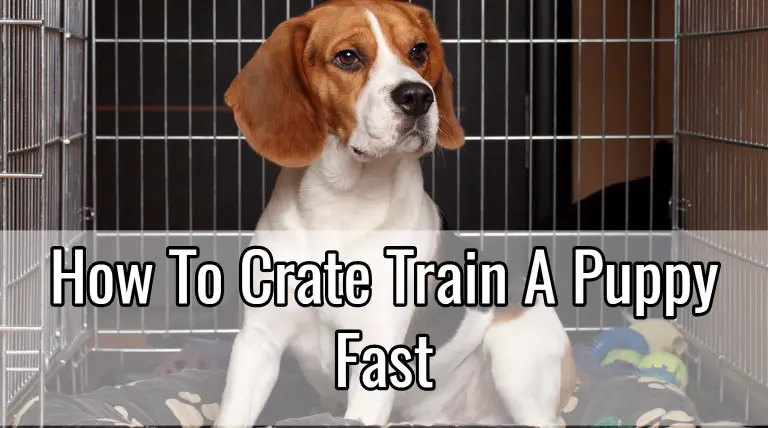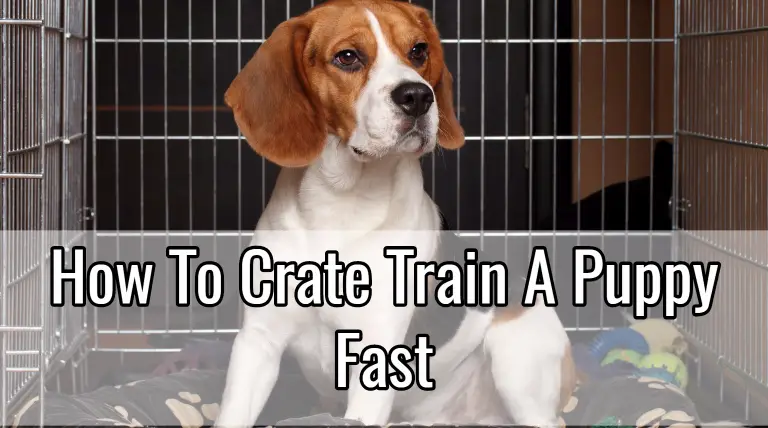Table of Contents
*This post may contain affiliate links. As an Amazon Associate we earn from qualifying purchases.
Crate training your new puppy can seem like a daunting task. However, once you have a bit of knowledge about the topic, you’ll be well on your way to a pleasant crate training experience for you and your puppy.
Keep in mind that dogs are den animals. In the wild, a dog’s den is their home. It’s a place they come to rest and seek shelter. So, when used correctly, a crate effectively becomes your dog’s den. It’s a place that they’ll come to feel safe and secure. These tips will help to ensure that you and your dog have a pleasant crate training experience. For more crate training tips (and other general puppy training tips) check out our Puppy Training 101 page.
Crate Selection
Visit any website or head to any pet store, and you’ll realize that there are lots of different options for your pet. The best dog crates will be the ones that adequately address the needs of both you and your pet. Considering there’s such a wide range of sizes, styles, and features available, you shouldn’t have a problem finding an appropriate crate for your pup.
Dog Crate Sizes
Whether you’re looking for small dog crates or a large crate for dogs, you’ll find lots of suitable options. The first thing you’ll want to account for is the size of your puppy, and how much you expect them to grow.
If your puppy is going to be doing lots of growing, you’ll want to look for a crate that’s suitable for the size they’ll be as an adult. Since your puppy will be growing into their crate, you may want to consider a dog crate divider while they’re still small. That way, the dog won’t be able to use a section of the crate for going to the bathroom before retreating to the opposite end of the crate to rest.
Types of Crates
There are three main styles of dog crates you’re going to come across in your search for the best dog crates. Depending on your needs, one of these styles is sure to be the right one for you when crate training a puppy.
- Plastic Crates aka “Flight Kennels” – These crates are made of molded plastic, and they are designed to meet IATA flight regulations for when you need to travel with your dog. If you plan on taking trips with your dog, this may be the best option for you.
- Fabric Crates – This style pairs a rigid frame, usually made of metal with a fabric covering throughout. These crates typically have mesh windows which provide plenty of ventilation for your pup. The frames are usually collapsible for storage. These crates are typically the most visually attractive, and they represent some of the best dog cages you can buy. If you’re looking for a crate that looks nice in your home, this style may be best for you.
- Collapsible Metal Crates – This style of crate is made of metal and is collapsible for easy storage. This style is among the most popular.
What Makes a Crate Safe?
When it comes to crate training a dog, keeping your dog safe, secure and comfortable is of critical importance. You’ll want to look for a crate that offers plenty of security. Not every dog is a Houdini, but there’s still plenty of escape artist pup’s who will make short work out of a faulty locking system on a crate door.
Make sure you’re purchasing a crate your puppy can’t break out of. Make sure that the material the crate is constructed of is suitable for your pup. If you have a very destructive puppy that likes to chew, a plastic crate probably won’t be your best option. Finally, make sure your dog is comfortable inside the crate.
You want them to treat the crate as a safe space, sort of like a bedroom. With that in mind, make sure your dog has room to stand and turn around inside of their crate.
Best Dog Crates
There are plenty of high-quality crates on the market, and these represent some of our favorites.
This collapsible metal two door crate is available in five different sizes, which makes it a strong choice for any size breed. It’s easy to set up and break down, and the addition of a 2nd door is very helpful. It includes a slide-out tray for easy cleaning.
Elite Field 3-Door Folding Soft Crate
This fabric crate is packed with useful features. Elite Field makes a fantastic large crate for dogs, and they’re available in six different sizes to accommodate smaller dogs as well. It features a durable steel frame and durable 600D fabric covering. It also folds for easy storage and transportation.
Sportpet Designs Rolling Plastic Kennel
These airline approved kennels from Sportpet are a great option for the dog owner on the go. They feature durable plastic construction and a wire door with heavy duty latch closure. Five different sizes are available, and the three largest sizes include wheels to make transport even easier.
Before You Start
Once you’ve purchased the crate that’s best for you and your dog, there are a few considerations you’ll want to make, like where to put a dog crate. Start by making sure the crate is inviting and comfortable. Consider adding a bed or a soft blanket to the crate. Place it in a room where you spend a lot of your time, such as a den or family room.
How to Crate Train a Puppy in A Weekend – The Step by Step Training Process
If you’re wondering how to crate train a puppy fast, this step by step guide is going to be very helpful to you. Remember to be patient and encouraging with your puppy, so they begin to associate the crate as a positive and not as a punishment. Puppy crate training is a lot easier than you think.
1. Introduce Your Dog to the Crate
Once you’ve selected where you’re going to keep your crate, it’s time to introduce your puppy. Keep the door to the crate open, and make sure it’s inviting inside. Bring your dog to the crate and speak to them with a bright, happy tone. Encourage your dog to enter, but don’t force them to do so. Once your dog feels comfortable with the crate, they’ll be happy to enter. Offering treats is a great way to get your dog acclimated quickly. Start by offering a treat near the crate, then offer one at the entrance to the crate and finally, all the way inside of it.
2. Feed Your Dog Inside the Crate
By feeding your dog in or near your crate, they’ll begin to associate the crate with a positive experience. If your dog is comfortable with their crate, feed them inside of it. If they’re a bit more skittish, try feeding them near the door of the crate. With each meal, move their dish closer and closer to the crate until they begin to eat inside of it.
3. Practice Crating Your Dog
Once your dog is comfortable eating inside their crate, allow them to spend more time in it. Create a crate training schedule to practice crating your dog when you’re home. Bring your dog to the crate, and encourage them to enter with a treat. Once they’ve entered the crate, give them a treat, and close the door behind them. Leave your dog crated for a few minutes at a time. Each time you and your dog practice crate training, increase the length of time they’re left inside.
4. Use the Crate When You Leave
Once your dog is comfortable in the crate and able to spend a half hour or so inside without feeling anxious or afraid, you can begin to crate them when you leave the house for short periods. You’ll also want to continue to crate them for brief periods when your home. That way, your dog won’t begin associating being in the crate with being left behind by their owner.
5. Use the Crate for Sleeping
Once your dog is comfortable with the other steps above, you can begin using the crate at night. You’ll want to keep the crate nearby, especially when you’re crate training puppies. This way, they can wake you up in the middle of the night if they need to be let out to use the bathroom.
Tips
- Only crate your dog as long as is necessary. If you’re often away for long periods, consider hiring a dog walker or taking your pup to daycare, so they get the exercise and socialization that they need.
- Extend crate time in small increments each day as your puppy is learning. As a rule of thumb, start by crating your dog for 10 minutes at a time. Each day, increase that time by 5 minutes. Once your dog can spend a half hour in the crate comfortably, you’ll be able to leave them for longer periods of time when necessary.
- Be patient, be reassuring, and encourage your puppy with treats. These tips will help ensure that you and your puppy have a positive experience with crate training.
- If you aren’t comfortable with using a crate with your dog, there’s plenty of alternatives you can look into, such as gates and pens. One of these options may be a more suitable option for you.
- For more training tips, check out the Dog Training Tutor!
Dealing with Problems
For some puppy owners, crate training isn’t the easiest process. If your dog is whining or acting out in an anxious manner when they’re inside the crate, it can be difficult to stay strong and not give into your puppy.
The first thing you’ll want to do is identify the cause of their whining. If your dog needs to use the bathroom and they’re whining to let you know, let them out right away. Go outside with your dog and when they’re finished, put them back in the crate.
If they’re only whining because they want to leave the crate, you must stay strong and keep them confined. If you give in to your dog and let them out of the crate when they whine, you’re setting a precedent that if they whine loud enough and long enough, you’ll let them out.
What Not to Do When Crate Training Your Puppy
- Don’t use the crate as a punishment.
- Don’t purchase a crate that’s overly large for your dog.
- Don’t keep your dog crated for extended periods of time while you’re home. The crate is not a substitute for supervision.
- Try to limit the amount of time your dog is confined to the crate while you’re away.
FAQS
How Long Is Too Long to Crate Your Dog?
The less time your dog must spend in the crate, the better. But, there are some occasions where you’ll need to crate your dog for a longer period. Try to limit these times as best you can and don’t expect a puppy to spend more than 2-3 hours inside the crate without being let out for a bathroom break.
How Long Does It Take to Crate Train A Puppy?
The time it takes to train your puppy will be different for each puppy. Some puppies will immediately respond to their crate and can be trained in a matter of days. Most puppies will need a bit more training, though.
How Do You Crate Train a Puppy When You Work Full Time?
If you’re the sole caretaker of your dog and you’re out of the house for 8 or more hours at a time, you may want to consider a dog walker or sitter for your pup.
How Do You Crate Train a Puppy at Night?
Look at #5 in our section on how to crate train a puppy in a weekend.
How Long Can You Leave Your Puppy in A Crate?
Avoid leaving a puppy in a crate for more than 2-3 hours at a time.


